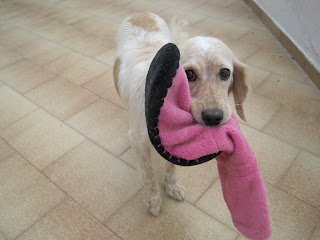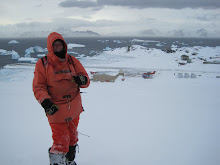After 5 days of false starts due to bad weather it was time to go. The waiting to leave was a weird time, constantly shifting between periods of intense activity and anti-climax as the transfer was posponed yet again. It also made cooking difficult to manage...I am not sure how many times the meat was taken out and then placed back into the freezer!.

When it did happen...it happened fast. All the luggage was thrown onto sledges and we were whizzed down to the sea ice where The Shackleton and the James Clark Ross took it in turns to shelter each other from the swell as each boat was loaded by putting their bows into the sea ice. I think getting up the gangplank on the Shak was probably the scariest experience of the trip. The sway was extreme and I couldn't keep my footing as it was so slippery. I thought I was going to end up in the water that lay between the boat and the ice before being grabbed by the scruff of my neck and hauled aboard! As you can see, John (beardless!) after 18 months on the ice, was keen to celebrate!

It was nerve wracking at first hearing the boat moving through the ice - it sounded like several million tin cans being crushed simultaneously. On the thicker parts of the ice the boat rose out of the water at the front to crash down on top of the ice to break it.
It was also amazing to watch how delicately this load of steel could maneouver through the ice, using its sideways thrusters to move away from iceburgs and find the easiest passage through the sea-ice.
I don't remember much more of the sea journey as I suffered six days of chronic sea-sickness...alternating between getting slammed against the wall in my bunk and waiting...anxiously...as the boat rose to the top of the crests of the waves...wondering if it was ever coming down again....the notorious Shackleton 'corkscrew' effect! Suzanna the Doc, kept me alive with frequent cups of tea!
Arriving at the Falklands it seems that history is everywhere. Shipwrecks litter the coastline. Passing Goose Green were the remains of the Vicar of Bray (above), one of the last Californian gold rush ships, rotting away by a jetty. On Stanley’s waterfront was the mizzen mast of Isambard Kingdom Brunel’s SS Great Britain.
Getting my landlegs back after spinning like a top for so long was a huge relief and I took the 4 days we had there as a chance to explore the main town a bit.
This distant relic of the British Empire has extraordinary wildlife, breathtaking scenery, historical relics and 700,000 penguins, 600,000 sheep (allegedly....I didn't see one) and 3,000 human beings in an area half the size of Wales. Cruise ship day-trippers excepted, this archipelago of 740 islands off the tip of South America attracts barely 1,700 tourists a year.
Stanley, the capital, resembles a remote Scottish town, with brightly coloured cottages, pubs, red telephone boxes, a lollipop man, British bobbies and mad taxi drivers.
We had left Halley just at the time when Argentina sabre rattled again over the hunt for oil by British firms in contested waters, but the story died soon after we arrived. However memories of the war between the two countries are everywhere to see.
There are still minefields around Stanley, festooned with skull and crossbones signs — if we fancied fireworks, cleared mines were detonated every other day.
One night we went to a really good restaurant — the Falklands Brasserie (lamb, squid and toothfish are the local delicacies) where copious amounts of good food and wine was quaffed...depite the fact that many sitting around this table were to run the Falkland's Marathon the next day (I would have too of course if I hadn't been so ill......) As it was, of the 72 competitiors in the race, only 3 were Falklanders. It would seem that they didn't fancy the thought of running in winds strong enough to snap off a Land Rover’s door accompanied by horizontal rain....strange.
On our last morning we were bussed to the RAF base to catch our flight home. I was a bit nonplussed when I saw who was taking us....Air Sechelles no less. A 7 hour flight took us to Ascension Island where we had a 40 minute stop over. It was odd to be hit by the heat and a great excuse to have an ice-cream!
8 hours later we landed in Brize Norton and the Antarctic adventure was over.
An amazing experience - when I was there it never felt like I was just bobbing about on an ice-shelf. Watching the modules being built was like watching something out of a sci-fi film. Everything about Halley was so structured and organised I never felt unsafe despite being in such an extreme situation. And I met some incredible people....oh yes...and I cooked a bit too....
From me...and all the Halley 'summerers'. Thanks for following our progress.
Hope to see you all soon.
Lx



















































 The new station will house about 50 scientists and support crew in the short Antarctic summer (December to February) and a skeleton crew of 16 for the rest of the year. The current Halley V is a raised station on steel legs and to avoid getting buried in the snow it can be manually jacked up. This takes a team of steel workers the full three summer months and requires the help of the whole base over a few key days. For Halley VI, a more sophisticated jacking-up system has been devised. Broughton had the idea of placing the base module on hydraulic legs attached to giant skis. It is a device that enables the construction to be raised up above the rising snow line mechanically with the assistance of the base bulldozers. The procedure takes only a week from start to finish.
The new station will house about 50 scientists and support crew in the short Antarctic summer (December to February) and a skeleton crew of 16 for the rest of the year. The current Halley V is a raised station on steel legs and to avoid getting buried in the snow it can be manually jacked up. This takes a team of steel workers the full three summer months and requires the help of the whole base over a few key days. For Halley VI, a more sophisticated jacking-up system has been devised. Broughton had the idea of placing the base module on hydraulic legs attached to giant skis. It is a device that enables the construction to be raised up above the rising snow line mechanically with the assistance of the base bulldozers. The procedure takes only a week from start to finish. The new inhabitants of Halley VI will also notice a major leap in the quality of their lives through the design and detailing of the new station's interiors. Halley V has been little more than rudimentary as a home, but Broughton has taken care to listen to the needs of BAS staff. The crew produced a wish list of things they would like to see from better sound insulation to quiet spaces, more storage and a larger gym, all of which have been worked into the new station.
The new inhabitants of Halley VI will also notice a major leap in the quality of their lives through the design and detailing of the new station's interiors. Halley V has been little more than rudimentary as a home, but Broughton has taken care to listen to the needs of BAS staff. The crew produced a wish list of things they would like to see from better sound insulation to quiet spaces, more storage and a larger gym, all of which have been worked into the new station.




